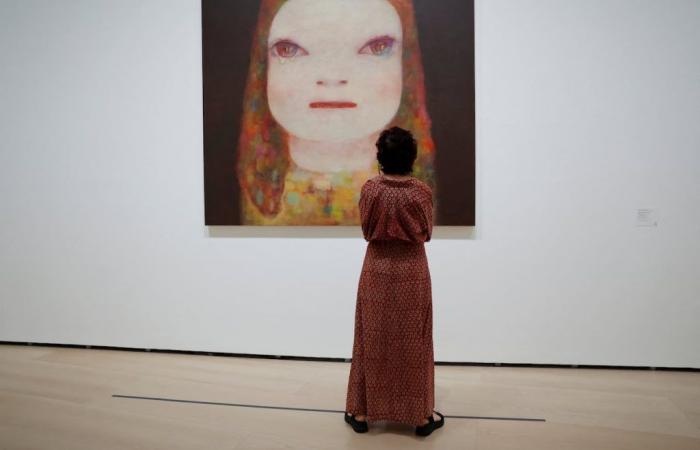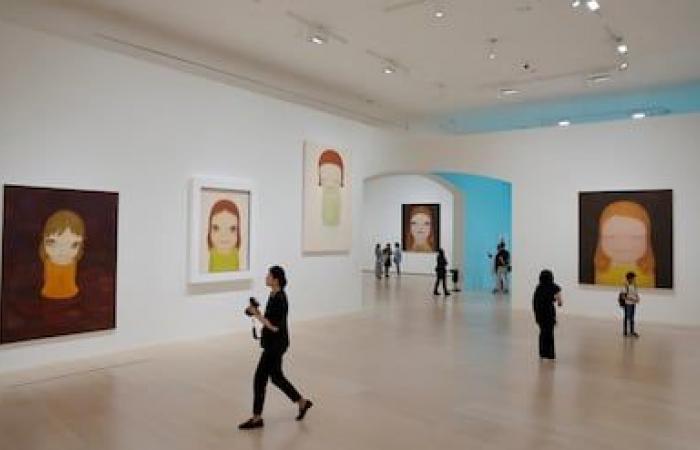Yoshitomo Nara’s girls (Hirosaki, 64 years old) are hiding something. There is something strange behind his orange slice-shaped eyes, behind his defiant, multicolored pupils, behind that childish but disturbing appearance. The work of the Japanese artist is on display starting this Friday at the Guggenheim Museum in Bilbao, in an exhibition made up of 128 works, including paintings, sculptures, drawings and installations; loans from all over the world in what is the first major exhibition in Europe of the Japanese artist.
“When the museum proposed it to me almost three years ago I didn’t believe it. I thought: couldn’t it be a lie? They had never given me an exhibition like this in Europe,” says the artist at the Bilbao museum. It’s nice to see Nara. She has a youthful appearance: only her white hair betrays her 64 years. He wears a red t-shirt that says golden years (a nod to the nostalgia of his younger years?), backwards cap, sneakers. She walks among her works without haste, in the immense open space that the Guggenheim has set up for its retrospective. The disturbing irises of his creations pursue him. One of the girls smokes. Another of her scratches her arm and it is not until the second glance that the drop of blood that slips under her hand becomes perceptible. Another walks through an idyllic background, if it weren’t for the expression of her closed eyes and the small band-aid on her forehead.
“We were looking for a retrospective of his entire career, a very personal reflection, that is why we have transformed the room to convey the landscape that he has developed in 40 years of career,” explains the curator of the exhibition, Lucía Aguirre, who defines Nara as “ one of the greatest artists of his generation.” The four decades thing is almost literal: the work starts with a drawing from 1984 and ends with a large-format painting of a girl, from 2023. “Well, they are girls because we say so, but they have no gender or age,” drops Aguirre, who defends that, although Nara has sometimes been pigeonholed in the movement japanese pop superflap (founded by Takashi Murakami, with whom Nara collaborated at the beginning), escapes that influence. “Many believe that I am influenced by manga,” says Nara himself, “when in reality I am influenced by the influence of manga, such as Japanese ukiyo-e prints.”
“In the movement superflat came up kawaii“says the commissioner. The cute thing. “But Nara likes the term more. kimokawaii”. Sort of repulsive; which causes discomfort. It’s true, and one of the best examples is the skin on girls’ faces: at first glance it seems white, but if you look closely you realize that there are thousands of colors together, that the blush appears, that They hide bluish spots. That feeling permeates all of the Japanese artist’s work, because there are not only paintings: in the center of the exhibition there is an installation – a disturbing full-scale dollhouse – and sculptures, such as the fountain formed by stacked heads in which the water , of course, springs from the girls’ slanted eyes. Furthermore, Nara not only paints on paintings, but also on wood, pallets, envelopes, and unmade cardboard boxes, which increases the strangeness of the whole. The titles of some works also embrace that rare mixture of tenderness and anxiety: sleepless night, In the deepest puddle, Harmless kitten, dead flower remastered, abandoned puppy, Missing in action, Mumps.
“We have thought a lot about his universe, about how his work will interact with our space. It has been difficult to bring all these works together. Many were difficult to obtain, they were spread all over the world. But he himself has helped us with loans, he has lent us many personal drawings…”, says Aguirre about the exhibition, which will run until November 3. Nara’s personal involvement is something that is highlighted by the entire team behind the exhibition, from Pablo Pujol, from the BBVA Foundation (which finances the work) to Juan Ignacio Vidarte, director of the Guggenheim who, at the end of the year, after almost 30 years at the head of the institution, will leave the museum. Indeed, the exhibition space, with paintings at different heights and an open space, has been designed by Nara himself. “His is a much more complex and profound universe than its appearance suggests,” Aguirre adds. “He is one of the great painters of our time, but above all one of those who best transmits human essence with his work.”
That work, in principle, would fit the profile of the Tokyo artist with pop sensibility and influenced by manga. But no, the painter came from Hirosaki, a small town in the extreme north of Japan famous because half of the country’s apple production comes from there. There, the small and sensitive Nara, son of a Shinto priest, stayed many days in his room instead of going to school. Like the hikikomori? “No, that’s a later concept. I simply stayed at home sometimes reflecting,” says the artist. At the age of eight he built a radio and with it he listened to the music of the US soldiers destined for Vietnam. Bob Dylan, the voices of the counterculture. He didn’t understand the language, but he soaked up the rhythm. Of blues and new genres. And the nostalgia of that music. He began to develop his style in the eighties, in Germany (he spent six years in Düsseldorf and another six in Cologne). He visited the Spain of the Movida. He took off in Los Angeles, where he acquired international projection, and with the new millennium he returned to Japan, where he adopted a more activist profile (he traveled to Afghanistan in 2003) that made an explicit anti-war flourish in his works. After the Fukushima nuclear tragedy in 2011 (the artist worked with displaced people who had lost everything) he reached what he calls a “stage of serenity” from which some of his most iconic works have emerged.
International fame, merchandising and mythical images aside, the big question remains in the air. Why these girls? What do the Nara figures hide? “If I could answer it, I would stop painting,” says the artist. “It’s something I can’t say with my voice. In fact, I’m very bad at expressing myself with words. That’s why I paint: so that my works speak.” Or to keep them silent. And look at us in silence.
All the culture that goes with you awaits you here.
Subscribe
Babelia
The literary news analyzed by the best critics in our weekly newsletter
RECEIVE IT
Subscribe to continue reading
Read without limits
_







